News publishers aren’t immune to Google’s AI Overviews. When Google rolls out the AI snapshot (a featured snippet on steroids), every industry will see organic search traffic disrupted in some capacity. But newsrooms might be better positioned to adapt to the new version of search than most organizations.
Let’s not ignore the fact that most media publications have been dealing with a depreciating business model for decades. Journalists have already experienced disruption moving from the analog to the digital. Revenue comes from ads, subscriptions, sponsorships, affiliate marketing, and events.
The largest news outlets are dealing with different challenges from upstarts.
Brand affinity and authority are massively advantageous, but reputation is still fragile. Look at the politicization of newsrooms across the spectrum. You cannot say that revenue hasn’t been impacted.
To complicate matters further, larger conglomerations are purchasing media outlets across industries and niches installing their roadmaps, revenue goals, and agendas.
The digital leaders of news outlets have an impossible challenge to grow, sustain, and adapt.
News media and Google have had a precarious relationship over the years. While Google has documented how they provide publishers with tools to support journalists and show up in Google News, Top Stories, and other features that drive traffic to their sites, it’s also lacked reliability and fairness (poor canonical reliability, AMP, and generative AI plagiarism).
Now, there’s an even bigger conversation already being discussed by SEOs and news outlet marketing executives. Generative AI.
- What role does it play?
- How will Google insert its large language models into search?
- How will that impact organic search traffic?
One big and important distinction before we go deeper. As of now, the Search Generative Experience only applies to normal Organic Search. Google News remains unscathed. That massive source of traffic from Google should remain untouched. While Google is capable of anything, to destroy that would be to completely destroy their relationship with the news media.
But aside from that small (potentially) silver lining, there’s a bigger question looming.
Do we block Google from using our content in its generative AI text?
The current (and harsh) reality? You can’t.
As of October, you’d need to block Googlebot to protect yourself from Google’s AI Overviews (SGE) completely.
For what it’s worth, it might not even matter. Your content will likely end up in sources like the Common Crawl which are also used in training data sets.
We don’t expect any of the largest news organizations to do block Googlebot any time soon.
Update: Barry Adams who writes the SEO for Google News Newsletter pointed out that “several huge publications have blocked ccbot in their robots.txt recently, including the NY Times and The Guardian. It’s a bit late now, as the LLMs have already been trained, but it’s still a significant symbolic step.”
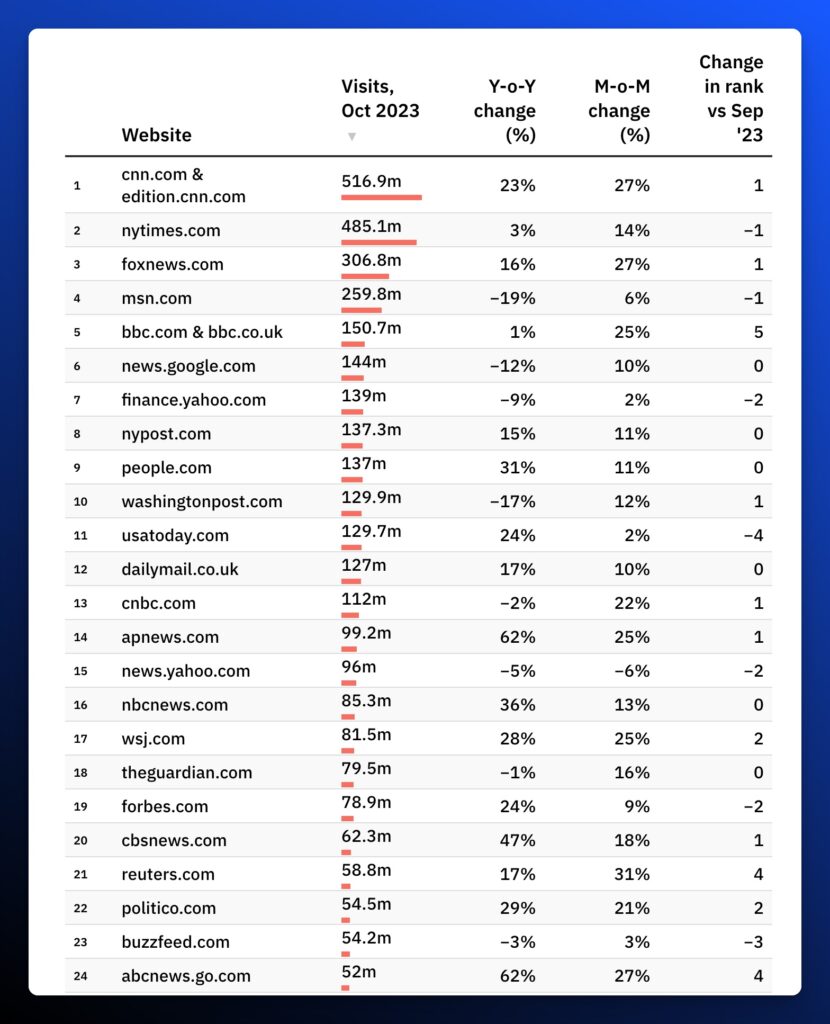
Source: Press Gazette
There’s also an inevitable copyright battle on the horizon between publishers and Google in the context of AI Overviews, but those legal suits can take years. So you need a plan regardless.
Established outlets have benefited from the recognizable and trustworthy brands they’ve built over time. A recognizable brand generates search traffic.
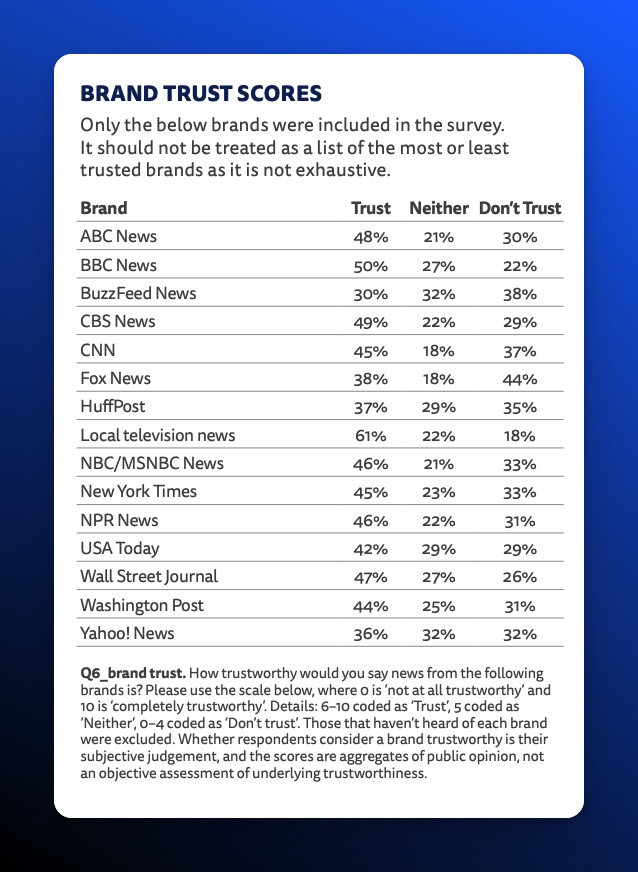
Brand Trust according to Reuter’s Digital News Report 2023
Why do news outlets need to address their approach to Google’s new AI experiment?
The AI Snapshot appears above Top Stories and organic search results.
If you’re missing from those results, you’re losing out on important visibility opportunities. See anyone missing for ‘News’ according to Google’s AI Snapshot?
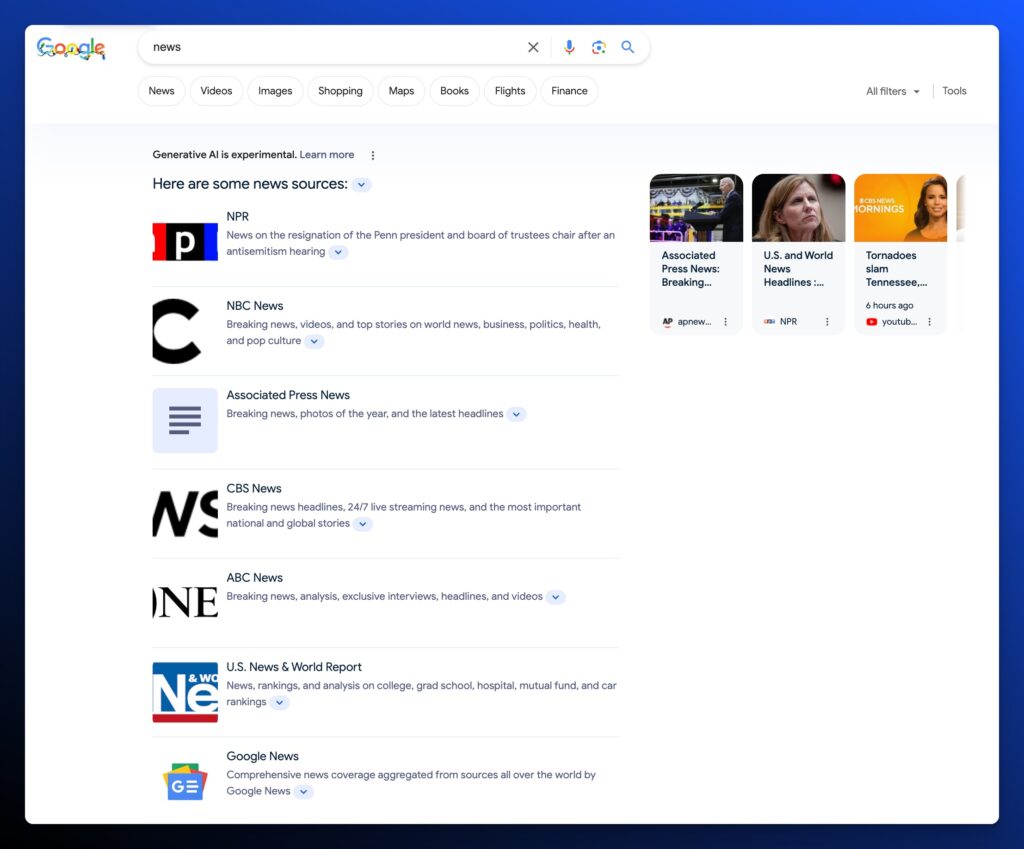
Results from Google’s AI Snapshot for “News”
Keep in mind that many search queries that news publishers target across informational, local, and eCommerce queries also are susceptible to AI Overviews.
What You Need to Know About AI Overviews
Let’s investigate what AI Overviews currently look like, the potential impact of AI Overviews results on news outlets, and what media publishers can do to prepare their sites and strategies so they don’t lose even more traffic to Google in this new iteration of search.
According to Srinivasan Venkatachary, VP of Engineering and AI Product Expansion at Google, via a 16-page internal document of the product (updated in October), the AI Overview is “an early step in transforming the Search experience with generative AI. When using [SGE], people will notice their search results page with familiar web results, organized in a new way to help them get more from a single search.”
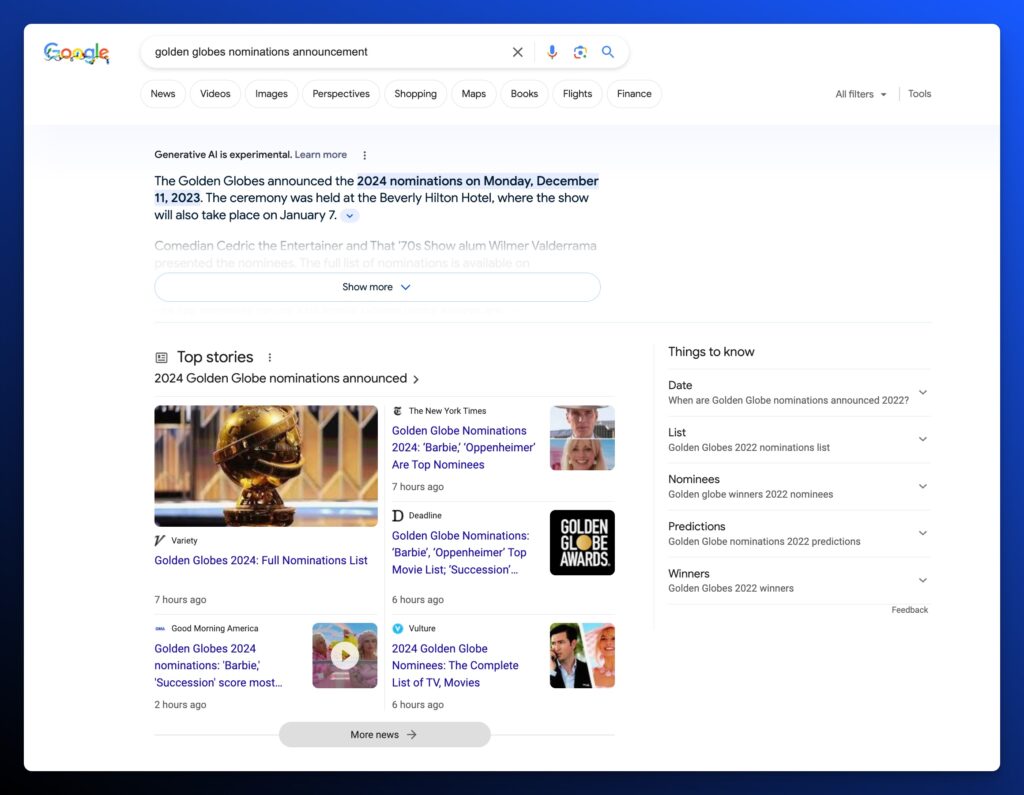
The experience includes:
- The AI Snapshot: A summary of generated text and links that serves to answer the query at a general level.
- Conversational Mode: An ability to add context and follow-up queries that can advance the journey with greater depth and breadth.
- Vertical Experiences: Goal-driven journeys specifically designed to surface a better shopping or local search experience.
Each of these elements of the product has significant implications for SEO that we’ll explore further in this post.
The AI Snapshot functions as a super-powered featured snippet. The display of the AI Snapshot falls into four scenarios for every search:
- Automatically generated at the top of the search results page.
- A message to “Get an AI-powered overview for this search?” with a Generate button to click.
- A message that “An AI-powered overview is not available for this search”
- No indication of an AI-powered presence.
AI Overviews is currently available in 120 countries and across 7 languages. To try AI Overviews for yourself as a consumer, you can opt-in to the feature in Google’s Search Labs.
Update: AI Overviews are now appearing publicly.
There’s a lot that we don’t know about AI Overviews. Juan Gonzalez Villa discovered the patent behind the technology and reveals how Google takes the query, generates an AI summary from relevant content on the web, evaluates the summary, rewrites it, and then annotates it with a graded level of confidence.
Mike King explains how Retrieval Augmented Generation (RAG) powers the process behind the AI Overviews patent. We’ll return to Mike’s discoveries on AI Overviews, but you can watch how he evaluates the AI Overviews threat level in his iPullrank webinar from November.
AI Overviews will not be limited to the AI Snapshot experience on mobile and desktop. Google is also experimenting with a version to supplement your search experience while browsing.
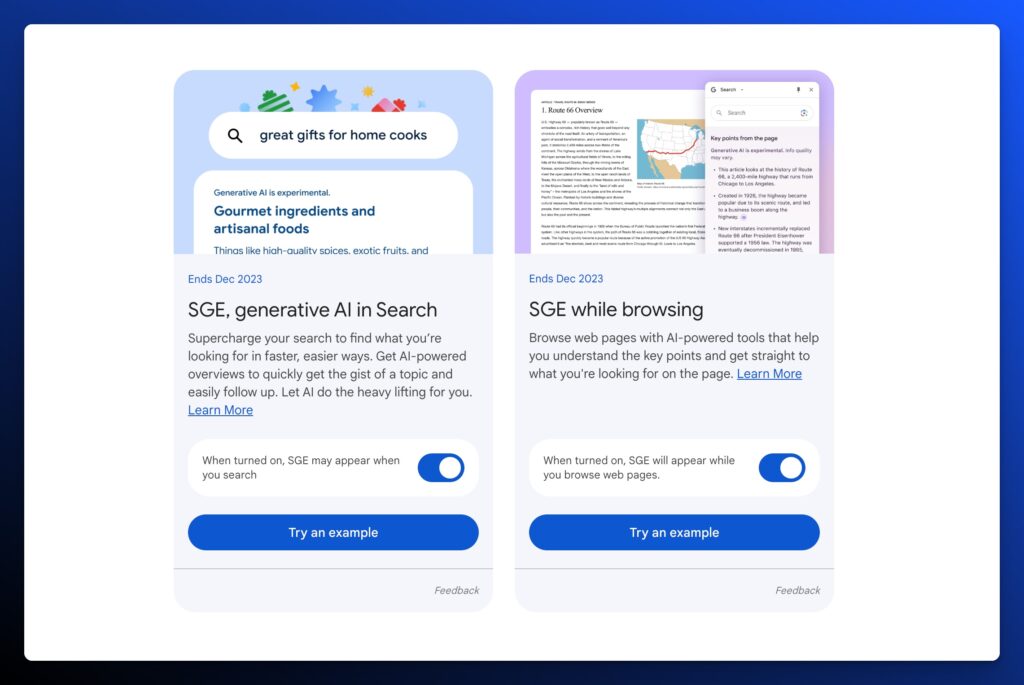
On Chrome, you’ll be able to click an extension icon that will reveal a side panel on your browser. The can be activated for ANY website. The AI Overview while browsing allows you to:
- Generate an AI-powered bulleted summary of the page
- Explore content on the page
- See related searches relevant to the page
- Learn more about the source
When you click to learn more about the source, you’ll also see:
- Web results about the source
- When the site was first indexed
- Info about the feature image
- More about the topic (including links to related and competitor content)
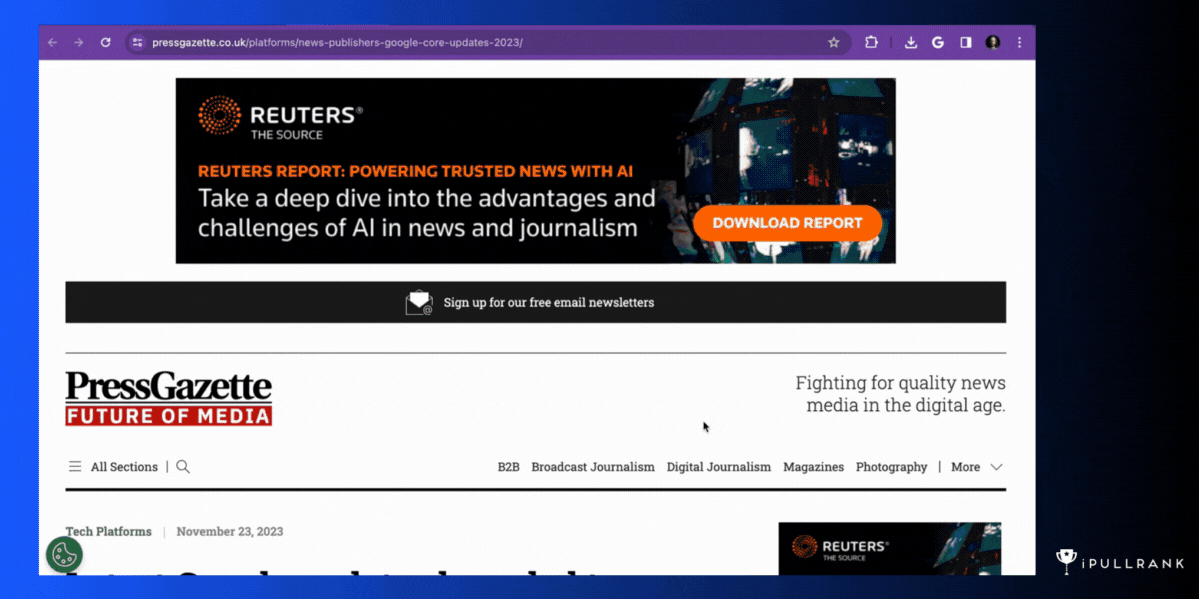
There’s also a version that can be accessed on mobile devices via a Bard/Information icon at the bottom of the browser.
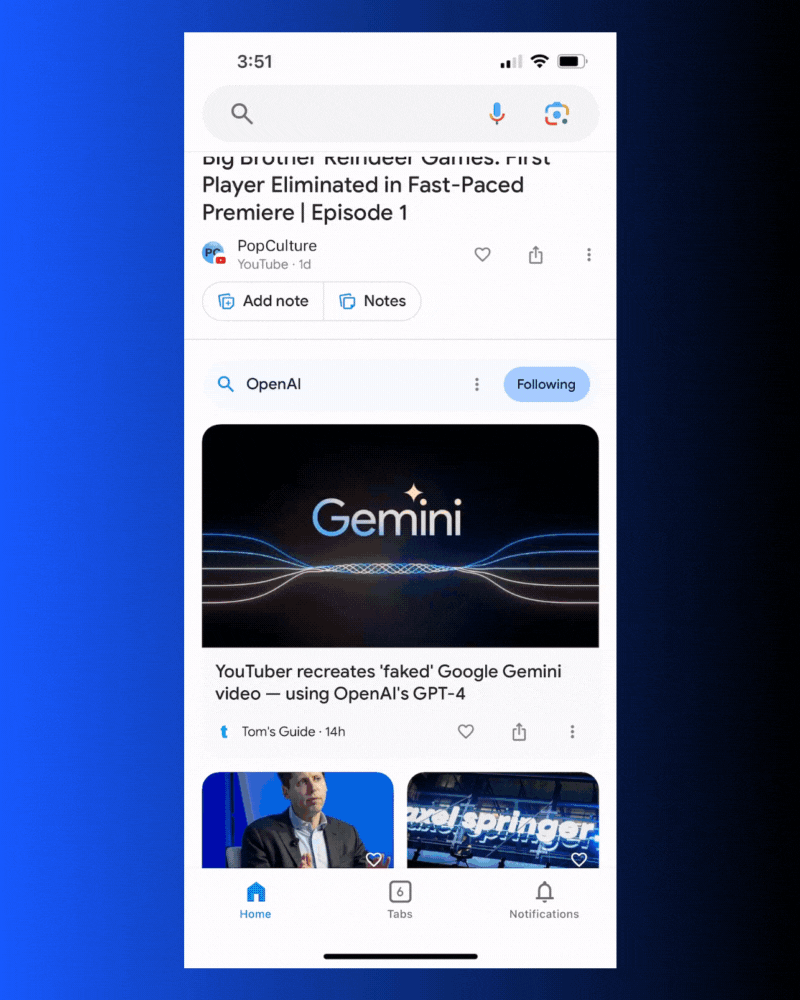
The implications of these features could mean that Google can steer your audience off of your website. Whether this will be another novelty that’s ignored by the masses is yet to be seen, but it’s part of the bigger picture that SEOs at news outlets need to consider.
A series of important considerations before we dive into the impact of AI Overviews on News Outlets:
- Constant State of Change: Google is rapidly iterating the results and the way it’s triggered. Since its release in May, Google has added citations within the generated text to attributed articles.
- Ad Impact: Because it’s in experimental mode, we do not know the precise role that ads will play in the final product. Currently, ads sometimes appear above the AI snapshot and below the snapshot, but not in the actual snapshot.
- Result Quality: Google does care about responsibly integrating generative AI into its products. The perceived quality of the results appears to be influenced by an abundance of caution to avoid generating factually incorrect, untrustworthy content. Originally, Google implied that important health, safety, and financial-related queries wouldn’t trigger AI Overviews snapshots, but upon rollout, that does not seem to be the case.
- Unknown User Impact: We don’t have any insights into whether people will click links inside the AI snapshot or scroll down to traditional organic results. We don’t know if searchers will click to trigger the snapshot in the first place. Different audiences will likely react differently. Some might be struck by the novelty of the AI-generated results. For more complex queries, searchers might still specifically look for brands they trust.
Is it a fool’s errand to predict how this will play out in the wild? Human behavior is unpredictable and this new version of search is improving rapidly, but the job of a business leader is to mitigate risk and part of that is addressing potential threats.
We need to speculate and make an informed decision. Responsible marketing leaders and SEOs are already taking precautionary measures to protect where they might be at risk.
The Potential Impact of AI Overviews on News Outlets
As AI Overviews roll out, we can expect extreme volatility in the SERPs.
We need to keep in mind that this will be a transitory phase. Regardless of Google’s extensive experimentation and testing, they’ve been known to be somewhat reactionary.
If they see a massive negative impact on ad revenue, we could see a rollback in the frequency of triggered AI Snapshots. If users spend more time on Google, they might turn up the dial. It’s hard to predict Google’s perception though. Spending more time on Google could be perceived as a negative thing as it relates to search quality.
News outlets need to be prepared with a strategy regardless of the outcome.
When Google first announced AI Overviews, they implied at the Google I/O keynote that AI Overviews would not appear on Your Money Your Life (YMYL) queries, but that’s not always been the case. Typically these queries fall under financial, health, and political content. But we’ve seen AI Overviews on everything from financial advisor-related queries to how to treat depression.
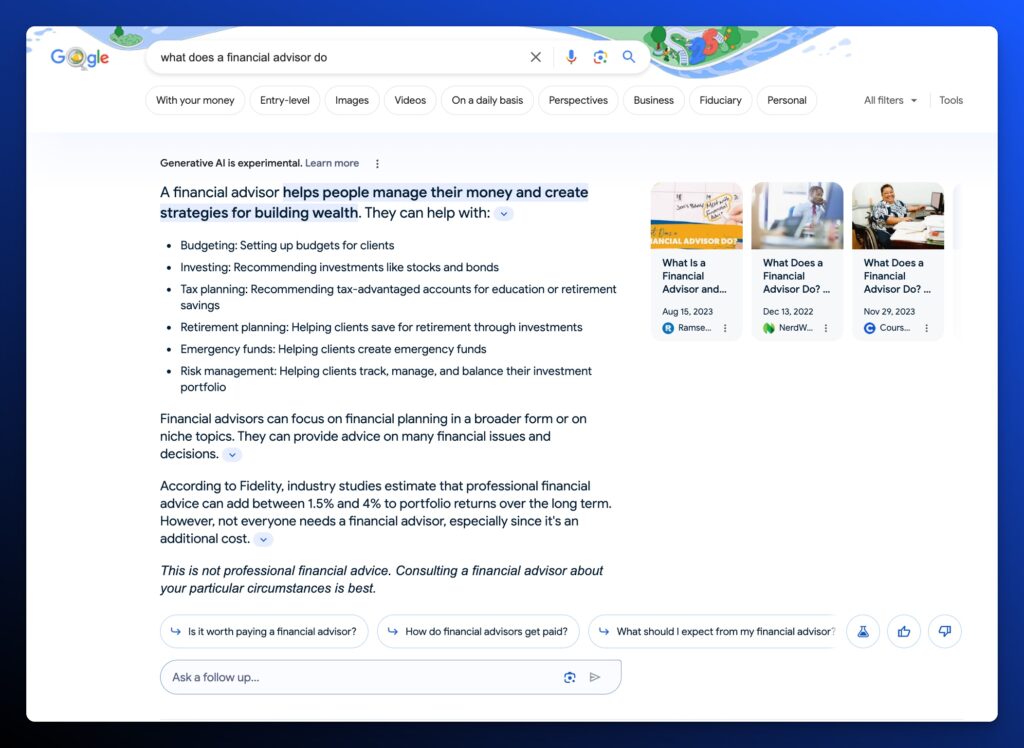
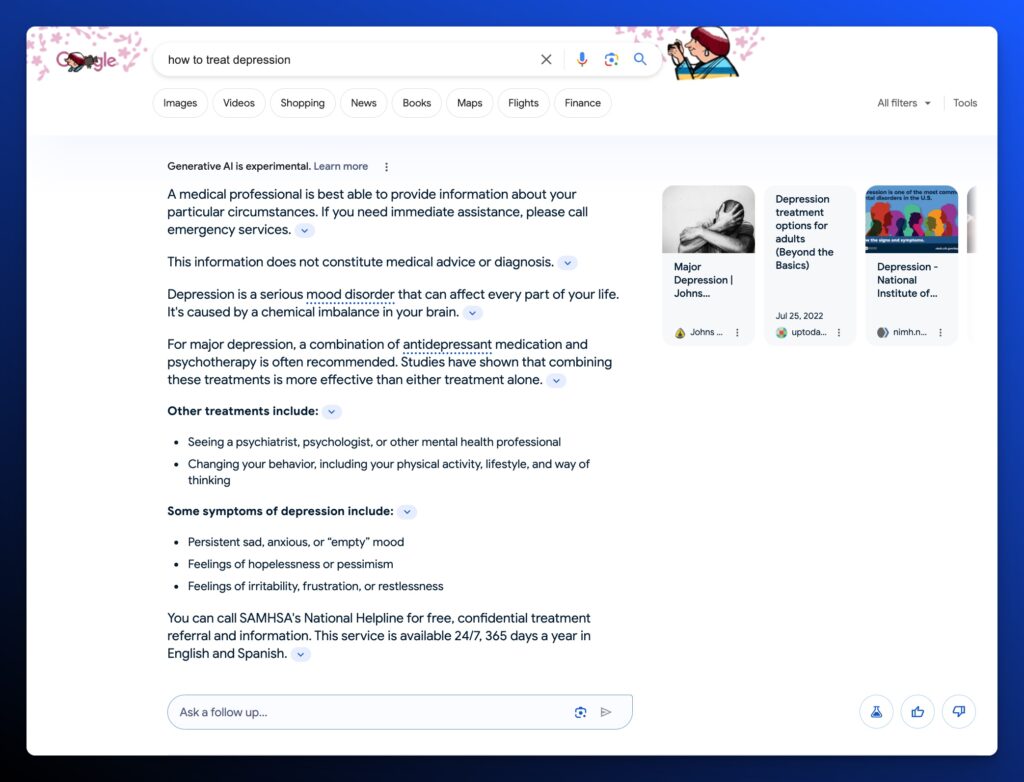
Google however holds back on breaking news queries that depend on authoritative brand journalism and require sensitivity. The last thing Google wants is an AI-generated snapshot that’s wrong, offensive, or deadly.
Here’s an example where it doesn’t appear for a recent series of deadly tornados in Tennessee:
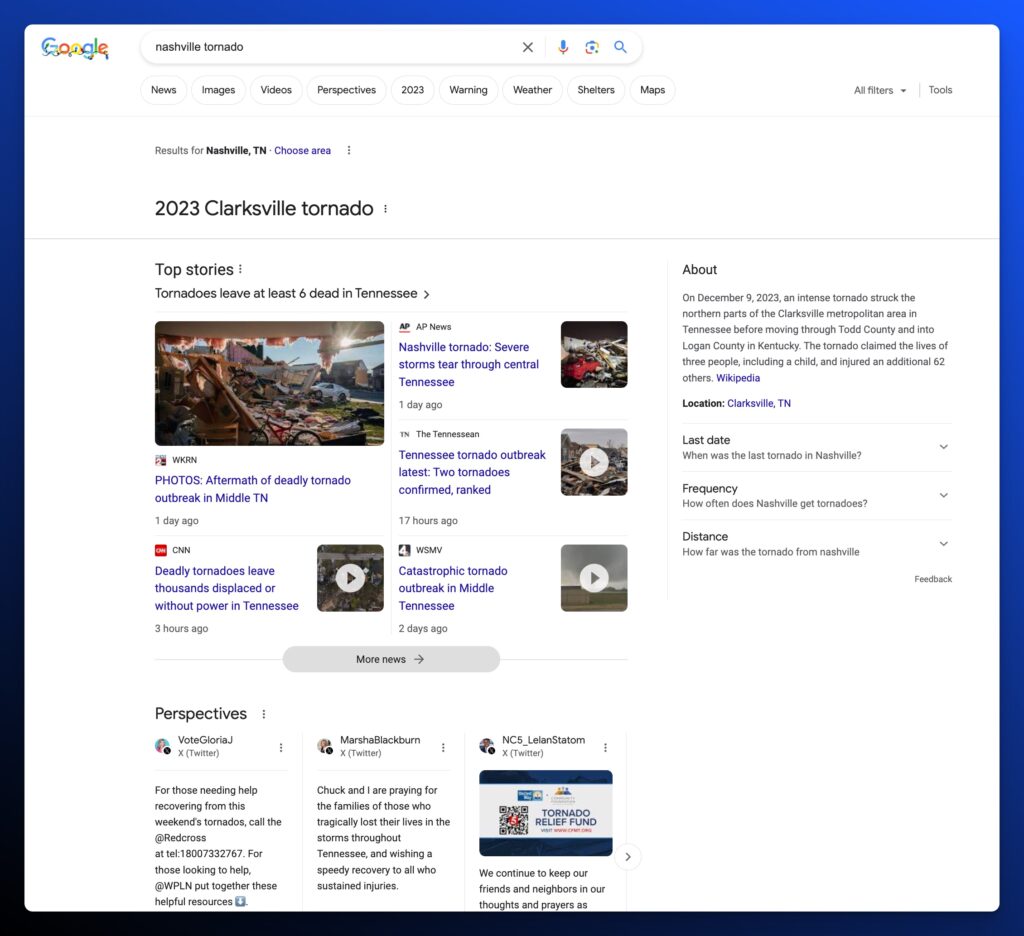
But your SEO team should still manually investigate where it’s appearing. Take for instance the sensitive nature of Israel and Palestine. AI Overviews can be triggered for the query “What’s happening in Israel?”:
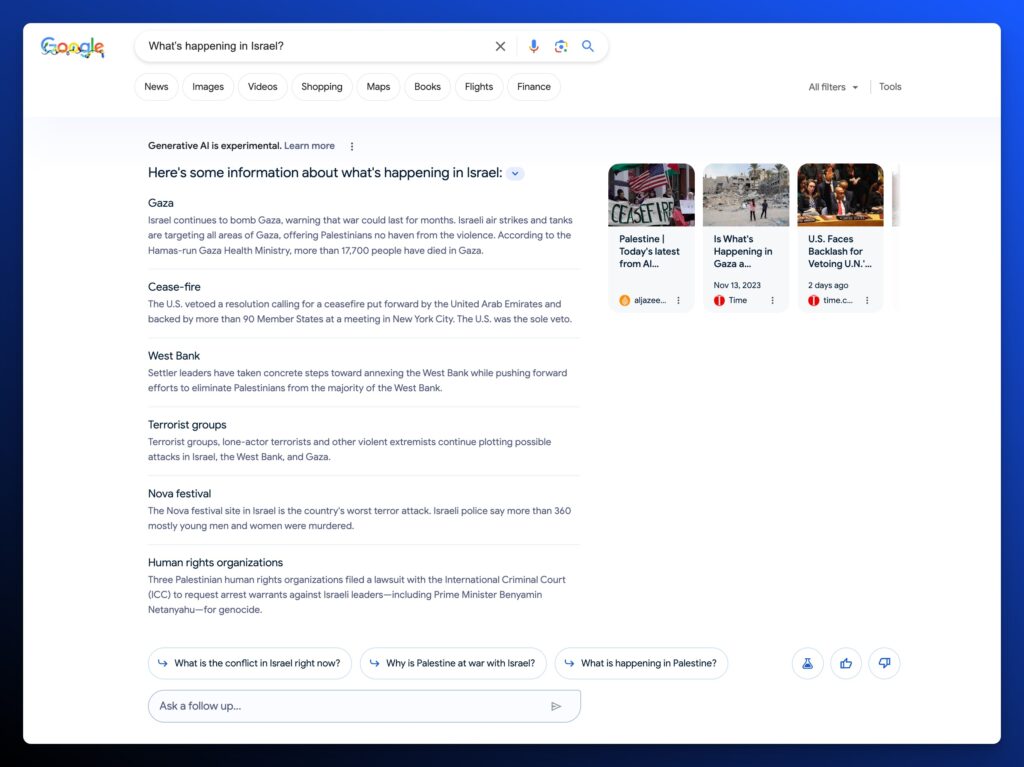
We don’t know whether searchers will generate the AI snapshot out of novelty or because they consider it an improved experience. But if Google decides to automatically generate the snapshot or if your audience does start to trigger it consistently, that’s a lot of traffic to risk losing to competitors.
Product Reviews, Affiliate Marketing, and the eCommerce Impact
The more dangerous and pressing concern for many news publications: the affiliate marketing play. In recent years, outlets like the New York Times have invested significant resources into product review content (Wirecutters) that drives revenue from affiliate links.
These editorial, in-depth reviews cover thousands of different products and have softened the blow of a decline in ad revenue. But AI Overviews will likely land a decisive blow on organic traffic to these product reviews. At least, that’s what much of the SEO industry is afraid of.
eCommerce commercial queries generate a completely different type of snapshot in AI Overviews. It still aggregates tips and insights about product decisions, but it includes the actual products inside the search results.
Let’s look at the same query side-by-side—first, the AI Overviews version.
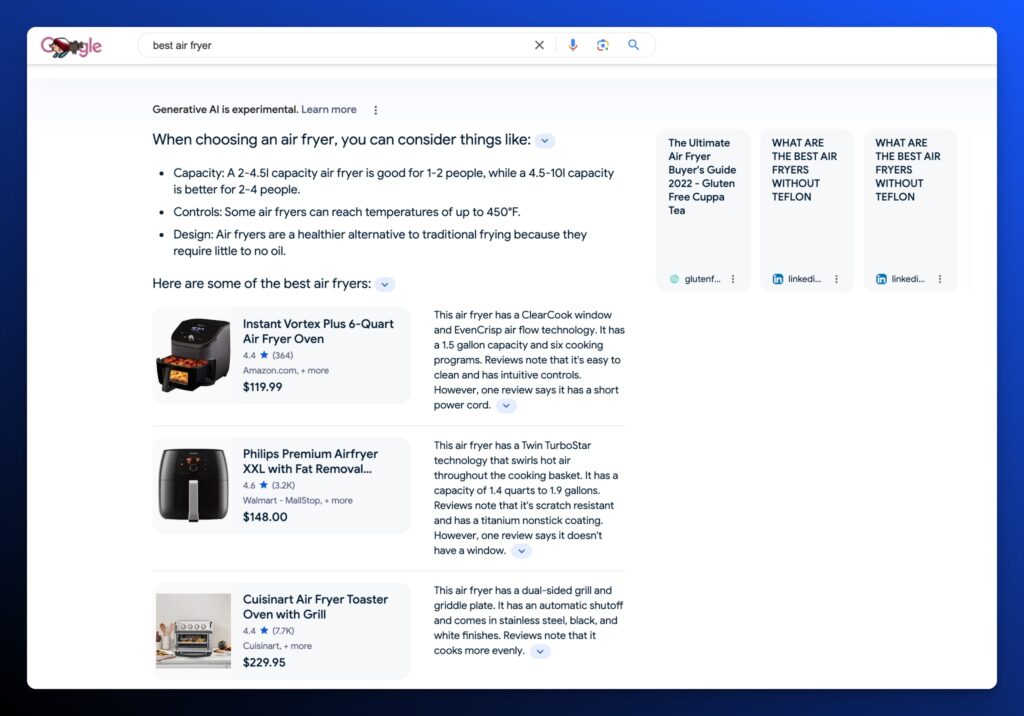
Now, we’ve got the existing organic version.
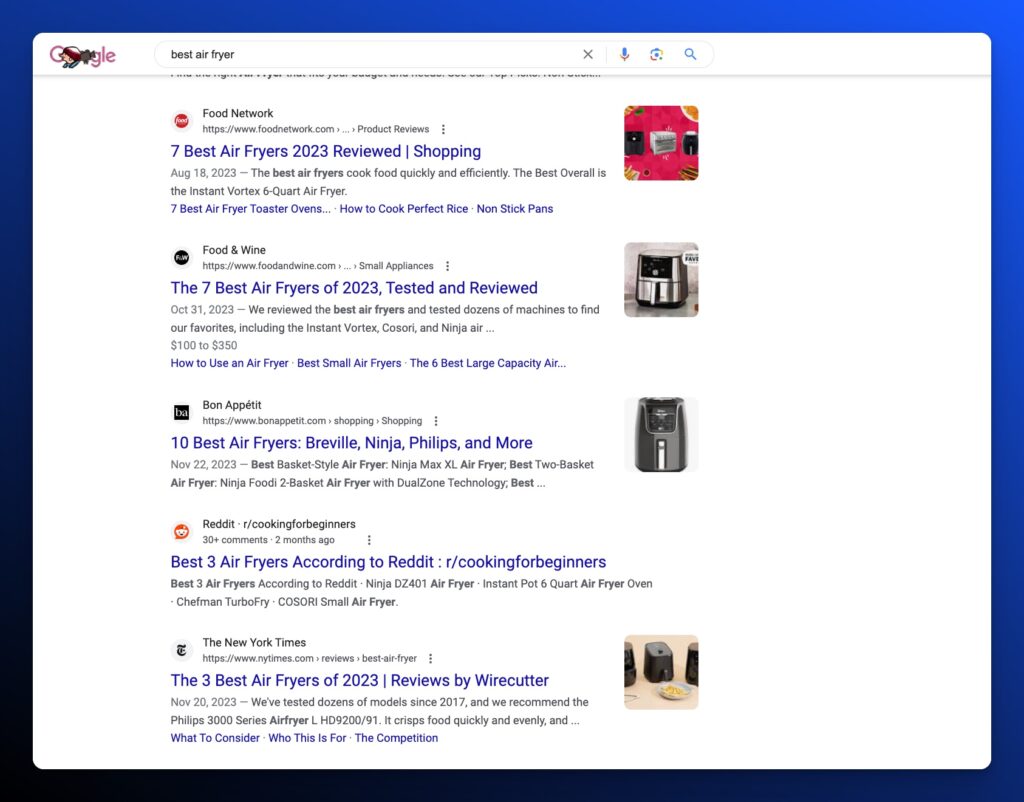
It’s a completely different set of sources. We only see one piece of affiliate-driven content in the AI Overviews version. The other two reference links are from LinkedIn (what??). Organic search is the standard murderer’s row of product reviews.
The difference is stark and terrifying.
Additionally, if you’re a news outlet, how confident are you that a random searcher (with a lack of affinity for your brand) will click on the AI Overviews result that links to your page and then choose the product from the affiliate link on your site?
That’s some significant friction between your editorial product review content and affiliate marketing revenue.
It’s a legitimate concern for news outlets and one they must resolve with creativity. Google still depends on this authoritative content to support its eCommerce AI Snapshot. So how will it play out?
One potential solution would be an adjustment to the affiliate marketing business model. Brands like Wirecutters, Tom’s, CNET, or any of these affiliate marketing sites could make sponsorship or content deals with brands but that’s unlikely to replace the revenue. This would not benefit the consumer. It’s hard enough to find impartial reviews. Online 3rd party reviews have been gamed and brands can’t write about their products objectively.
This is one of those aspects of AI Overviews that could have a massive unintended effect on consumer experience.
This leads to the key question that news desks need to address immediately:
Should we invest in optimizing our news content for AI Overviews?
Google does not provide the ability to block the generative AI crawlers from accessing your site, but if it does what should you do? The debate became important when OpenAI provided websites with a directive to block its chatbot via the Robots.txt file.
Ryan Jones of Razorfish makes a compelling case that you should take a wait-and-see approach. Despite talking about ChatGPT, the same argument can be made for Google’s AI Overviews:
“OpenAI says it will cite sources when plugins pull data from third-party websites. This means there will definitely be potential to get clicks from ChatGPT if a user pulls in your content.
Blocking access only means that ChatGPT (or your user) will cite somebody else’s website.
Many people having this debate start with the flawed assumption that if people can’t get the content from ChatGPT, then they’ll have to visit the website.
I don’t think that’s true. The reality is that they’ll get the content from your competitor.”
Before exploring what your organization should do, let’s consider the pros and cons of AI Overviews.
Positive impacts:
- Increased visibility and traffic: AI Overviews can help news outlets reach a wider audience by jumping to the top of the search results. If you typically don’t rank for top queries, due to competition from the top news brands, AI Overviews might provide a better chance at ‘getting lucky.’
This could lead to increased traffic and engagement, particularly for smaller outlets that struggle to compete with larger publications. It could also benefit larger publications that optimize for AI Overviews. But if we’re being honest, this is like offering ‘exposure’ to a content creator without clear compensation.
- Improved user experience: By providing concise and easy-to-understand summaries of complex topics, AI Overviews can improve the user experience for news consumers. This could encourage users to stay on the search results page longer and engage with more content. But this also benefits Google more than your outlet.
- Enhanced brand awareness: News outlets can leverage AI Overviews to promote specific brands and topics, potentially leading to increased brand awareness and recognition.
- New opportunities for monetization: AI Overviews may open up new avenues for news outlets to monetize their content. For example, they could partner with Google to display targeted advertising alongside their AI Overviews summaries. This is what Google most likely is hoping for.
Negative impacts:
- Reduced traffic: If users find the information they need directly in AI Overviews summaries, they may be less likely to click through to the original news articles. This could lead to a significant decrease in traffic for news outlets, particularly those that rely heavily on organic search referrals.
- Loss of control over content: News outlets may lose control over how their content is presented in AI Overview summaries. This could lead to misinterpretations or inaccuracies, potentially damaging their brand reputation.
- Increased competition: With AI Overviews providing summaries of various news sources, it could become harder for individual outlets to stand out and attract attention.
Overall, the impact of AI Overviews on news outlets will likely be mixed, but leaning negative. While it presents real opportunities for increased visibility and engagement, it also poses significant risks regarding traffic loss and reduced control over content. There are too many unknowns at this point. News outlets will need to adapt their strategies.
Here are some additional factors to consider:
- The specific implementation of AI Overviews: The final impact of AI Overviews will depend on how Google chooses to implement the technology. It is possible that Google will address some of the concerns of news outlets, such as by providing attribution for content and allowing news outlets to opt out of AI Overview summaries.
- The ability of news outlets to adapt: News outlets that are able to adapt their content and strategies to take advantage of AI Overviews are more likely to succeed. This may involve creating content that is specifically optimized for AI Overviews, such as short summaries and bullet points.
- How other publishers react: The media landscape is constantly evolving, and new technologies are emerging all the time. News outlets need to be prepared to adapt their strategies to remain competitive in this dynamic environment.
Ultimately, the impact of AI Overviews on news outlets will depend on a variety of factors. However, it is clear that this technology has the potential to significantly change the way news is consumed and distributed. News outlets need to be aware of the potential risks and opportunities associated with AI Overviews and develop strategies to adapt and thrive in this new era of search.
News outlets have complex search journeys. They generate organic search traffic from:
Time Sensitive Content:
- Breaking news stories
- Top stories driven by journalism
- Trending stories
Evergreen Content:
- Consumer education stories
- Content hubs and pieces around entities (people, businesses, places)
- Product Reviews and Affiliate Marketing
Both categories drive the brand and revenue.
Despite the wait-and-see approach from many of my colleagues in the field, I don’t think you can afford to ignore or even avoid the impact of AI Overviews. There’s too much at stake.
What Can News Outlets Do To Prepare for AI Overviews?
Confronting generative AI for journalists is uncomfortable. By playing the game, you’re capitulating to Google’s content theft. Every news outlet is structured differently, but your SEO, technical team, editorial, and developers should all be working together to focus on strategies that will ultimately keep the lights on.
Intentionally avoiding the AI snapshot could be considered a move to cut off your nose despite your face.
Expert Perspectives from News SEOs
I reached out to a few SEOs in the industry for their perspectives on how to move forward. Everyone has a nuanced take.

Glen Allsopp, Founder of Detailed
For the most part, media outlets fall into three camps:
- Genuinely seem to be concerned about the future of SEO
- Don’t appear to be concerned at all and are continuing as normal (or at least that’s the impression they give)
- Alert to what might change and working towards reducing their reliance on Google, but willing to see how things play out before doing anything drastic.
I think the third camp is the approach I would recommend. Monitor what’s happening in search results and what appears to be working for others, but keep a focus on what’s currently working for your site right now and try not to get too caught up in any major changes you might regret.
Continue building a brand people would seek out in search results and miss if they don’t see you ranking. Being focused on alternative traffic & revenue sources is good (newsletters, social media, on-platform views with ads in them) but that isn’t a new thing. It has always been smart to have at least some focus on growing your reach via other channels.
Nobody knows what things will look like a year or two from now or what will fully roll out but that goes for any platform.
We’ve had X reducing traffic to certain major news sites. Facebook link reach diminishing and even blocking Canadian news entirely.
New rules coming regarding email promotions and engagement rates for newsletters. I could give more examples of platform risk outside of search.
So in summary, stay on top of what is happening and be prepared to act if needed, but don’t do anything too drastic if search is working well for you and/or close competitors right now.

Shelby Blackley, Newsroom SEO Editor at The Athletic & co-founder WTF is SEO? newsletter
Wait and see. SEO truly is the wait-and-see industry. The catapult of AI and the creation of Search Generative Experience was the dominant trend of the year — but every time we thought it was going to alter the search engine experience as we knew it, it really didn’t. Sure, traffic is fluctuating, but that’s always happened in search. That’s not to say there aren’t implications of this technology — and the current experiments of SGE show the concerns that come from using AI. A lot of the industry’s concerns right now are around the integrity of the product, and that is very fair. Integrity is the cornerstone of journalism. But publishers are beholden to the off-platform tech giants, which have very different goals.
There’s so much we don’t know. The technology needs work. There are many legal implications for companies that are using AI without permission — which could take years to figure out. Patience and future-proofing are more important than ever, so look at how you can set your publication up for success instead of concerning yourself with protecting what you currently have.
SGE’s emergence provides publishers a chance to turn the mirror on themselves and determine whether the content they provide is useful, trustworthy, and authoritative. Go all in on your niche. Provide more avenues for on-site engagement. Create a newsletter community that returns regularly. Experiment with content types. Honor local priorities. Deprioritize areas that take too much time, and use AI to make your mundane tasks easier.
Google needs news. Its ecosystem relies on publishers providing information that its readers can apply to their everyday lives so they continue to come back and use the platform. As the technology continues to iterate (and Google strikes agreements with governments across the world, including Canada and Australia, about paying for news), it’s imperative that publishers continue to iterate. Change is constant. Accept change, and get good at it.

Alli Berry, SEO & Content Strategy Consultant
It feels like we’re in a bit of a wait-and-see moment with SGE. This isn’t the time for publishers to start scaling a strategy as the results are quite volatile at the moment. Most of the SGE I have seen in the SERPs has been on broad, evergreen queries, and I think this is good news for news publishers.
It will always be harder for Google to replicate news coverage with AI. Being timely should continue to be a win for humans creating content for publications because AI-generated content is only as good as its dataset. It can’t create content about a breaking topic it hasn’t yet learned about.
If I were a publisher, I would be de-prioritizing evergreen content as a strategy recognizing that SGE is likely coming for those more basic, broad queries. I would instead focus on ways to differentiate from AI – timely, quality reporting with quotes from real people. I would start studying what is getting pulled into the SGE and try to reverse engineer why. There will be an opportunity to drive more shopping traffic if you can get yourself into those SGE areas of the SERP.

Kevin Indig, Growth Memo
- Potential impact: I just want to flag that nobody knows for sure what will happen with SGE because a lot can change. I’m not convinced we’re seeing the final version of SGE. But if it launches the way it looks right now, publishers will lose a lot of affiliate revenue. I think their Google News and Discover income is safe for now.
- What should news outlets do: Get good at Google Discover and better at Google News – go all in on expertise in their content.
I think generally, publishers are in a bad spot and it will get worse. The best outcome for them would be to get bought by a tech company or find a licensing agreement with Google or LLM makers.

Jessie Willms, SEO editor and co-founder of the WTF is SEO? newsletter
Google has been expanding its footprint in search results for a long time — taking more real estate for itself around major news events (see: 2023 Golden Globes nominations. Easy content – the Winners & Nominees file – is now easily accessible in search results). With SGE, Google is likely to take even more ground for itself – but that’s nothing new. And it shouldn’t be a huge, existential concern for outlets. Instead, publishers should take SGE as an opportunity to reflect on the value they can add for readers on queries where Google is likely to serve a generative experience. How can you create content that does something or provides value to readers that Google cannot? Yes, Google will invariably encroach on your traffic – but take stock of the clicks you’re losing. Are they readers who stick around? Or are they sugar-rush page views? Can you shift focus to the queries and questions Google can’t answer?
Once users are on-site, focus on providing the best possible reader experience. That means super-clean sites that aren’t bogged down by relentless advertising and video or newsletter popups. Not only does that build reader trust, but as Barry Adams often says: The best defense against the whims of Google’s algo updates is strong reader loyalty. Focus on what you can control: Providing a dynamic mix of content on your homepage, a strong recirculation campaign on article pages, and – obviously – whip-smart, helpful content.
As Shelby articulated in a recent newsletter, publishers can (and perhaps should) block Google-extended, the crawler that trains Google’s Bard and Vertex AI generative APIs. Google wants to use publisher content to train its products for free. Don’t let it.

John Shehata, CEO and founder of NewzDash (also founder of NESS News SEO Conference)
Many publishers have affiliate content on their sites that link to Amazon and other external commerce sites where they earn commission. I predict that this revenue will be impacted as when users interact with SGE and see the recommended product, they can see price comparisons for all these products on the same screen.
My recommendations to prepare for SGE:
- Brands need to invest in building authoritative profiles (E-E-A-T) of their writers and experts.
- Brands should also empower their writers to have an engaging presence on social media – become creators – and produce social content to promote their writing.
- Entities (Person: schema) will become an increasingly important entry point for the Perspectives tabs, especially providing social “proof” on the authenticity of the author.
- Brands should invest in UGC – User Generated Content – either on their sites (comments, forums), and/or having a strong presence in public forums.
- Brands should invest in short-form videos not just for SGE, but it is a great fit for Social Media (Instagram Reels, YouTube Shorts, etc.)
- SEOs will need to make sure that their content is well-organized and easy to read. Having proper Schema is no longer a luxury but is a must.
- SEOs will need to make sure that their content is up-to-date. Content refreshes must be part of the workflow that publishers adapt and part of the writers’ quota.
- SEOs will need to make sure that their content is optimized for mobile devices.
- SEOs need to ensure that their videos and images are well-optimized as Google is becoming more visual.
Independent of the holding pattern strategies, if you’re intent on competing for AI Overviews, Google has provided clues for you to appear in the snapshot with a link that may or may not deliver traffic to your publication.
You can begin to reverse engineer the results.
To get a sense of how Google is identifying relevant content, let’s return to Mike King’s deep dive into AI Overivews and Retrieval Augmented Generation.
He investigated a keyword set of 91,000 keywords and came away with a few important insights.
Where does AI Overviews source content?
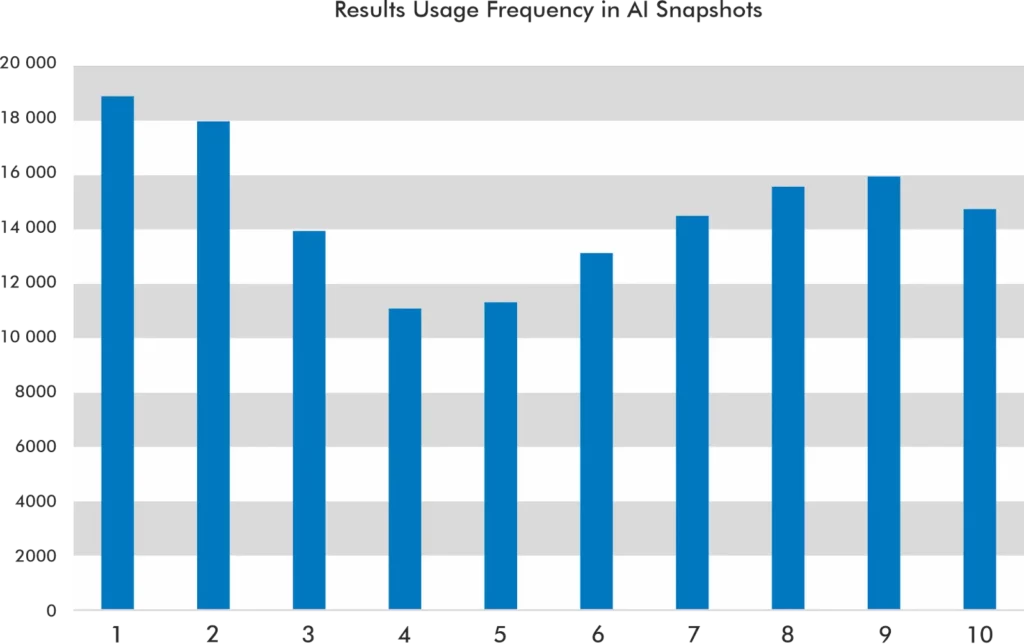
- Organic content from positions 1, 2, and 9 are most likely to be incorporated in the AI snapshot’s carousel.
- 9.48% of the time, it does not use any of the top 10 results in the AI snapshot.
- 60.34% of queries from the dataset did not feature an AI snapshot.
Mike also discovered that Google pulls chunks (passages) from relevant content and aggregates them to build the generative AI snapshot text.
He built a tool for you to identify and investigate the chunks for your targeted query – Raggle.

But what’s interesting about the passages that AI Overviews pulls, they’re explicitly the most relevant chunks. Google is possibly pulling from a variety of related queries and generating the text. When Mike compared the included passes to the generated text, the chunks were more relevant to the AI snapshot text than the original query alone.
This is our clue for reverse engineering. Keep in mind, that this is speculation and that the slightest adjustment to the query could influence the generative AI snapshot.
It’s not likely that optimizing for one query will work across the entire topic. But you can repeat this process for the follow-up prompts included below the snapshot.
So how does all of this work?
Let’s take an important query that will be relevant to many news outlets over the next 6 months: 2024 Olympics.
Here’s what it currently looks like in AI Overviews:

We see that Google currently pulls in:
- a recent YouTube video on the Olympic Food by WKOW 27 News
- The 2024 Summer Olympics Entry on Wikipedia
- The Official Paris 2024 Olympics Website – Sports Page
- The Official Olympics Website
- The Official Paris 2024 Olympics Website FAQ Page
Before diving into the chunks, you can also see how AI Overviews is moving beyond text to include video in the results. It’s not clear if the content around the menu is from the transcript or the actual video using Google’s newest LLM, Gemini, but either way, adding a transcript is critical for accessibility.
Important takeaway from the included video: it was published only 17 hours ago, so you can see that there’s an element of freshness considered in these results. That’s your news team’s secret weapon. You could build an entire YouTube strategy around fresh videos for targeted topics.
The AI Overviews follow-up questions for this query include:
- Where will the 2028 Olympics be held?
- Where are all the Olympic venues located?
- Why are the Olympics every 4 years?
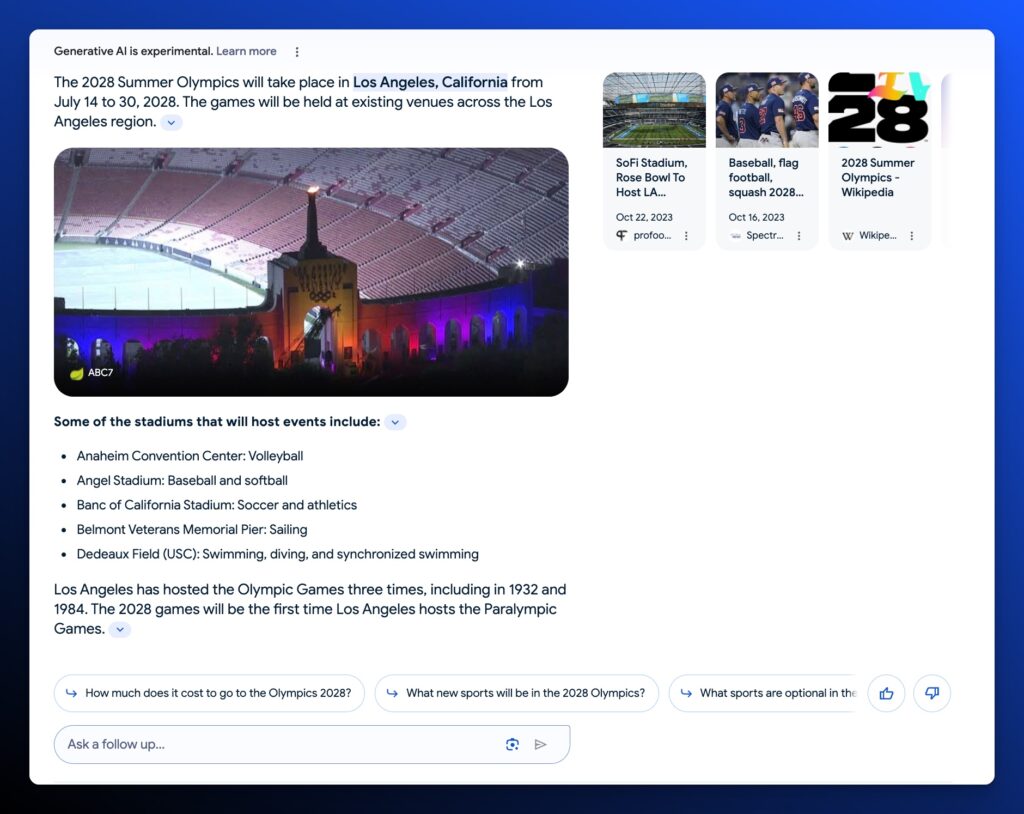
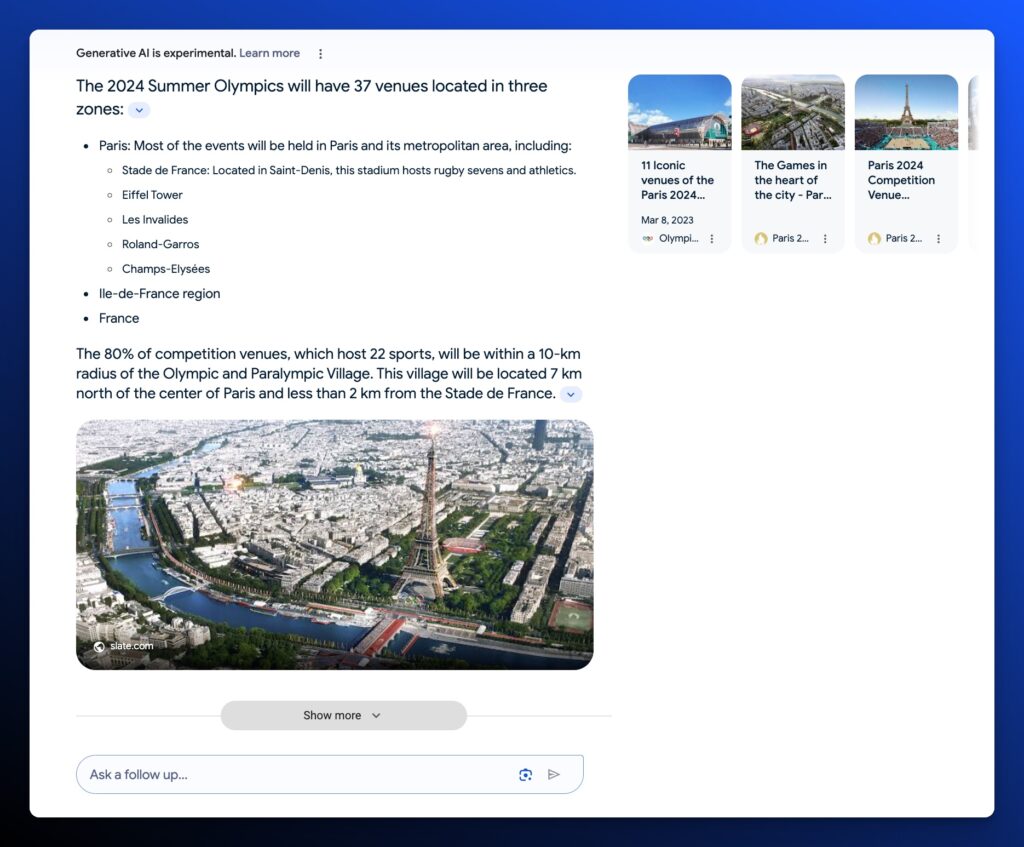
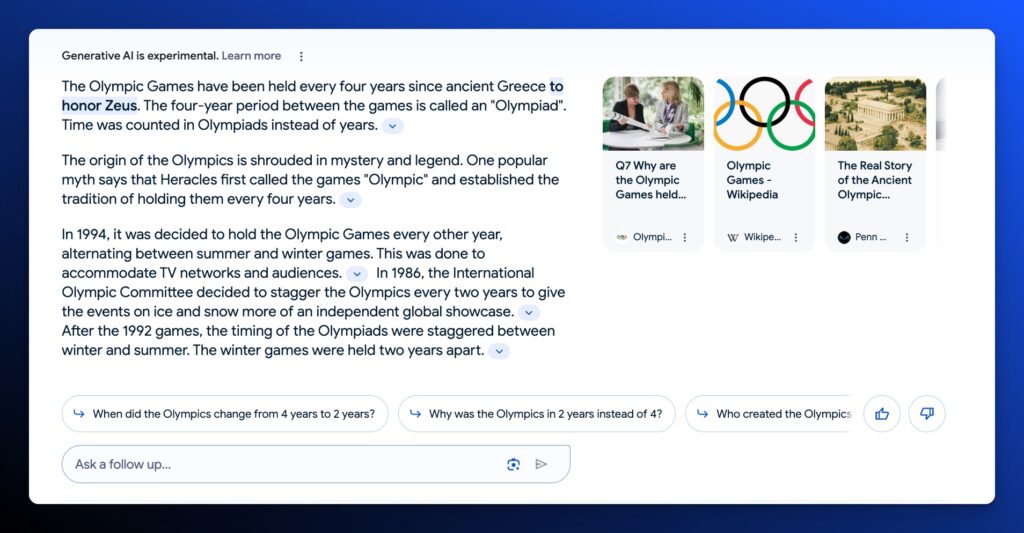
You can begin to see the journey that AI Overviews takes you on from these follow-ups and the supported sources.
Looking at the chunks, we can pinpoint the relevant content that’s pulled by AI Overviews.
Here’s an example of the chunks identified by the Raggle tool for the keyword Olympics:

You can parse out the important facts for each of the chunks and use that to update your topic pages or relevant pages with that content. Regardless of the immediate dividends, you’ll be able to fortify those topics over time and give your outlet a better chance at showing up for more relevant queries on the topic.
As you connect your topic pages to the various articles via internal links and update them with relevant content reverse-engineered by AI Overviews to prioritize that chunked content, you’re likely to see that benefit your presence when breaking news develops.
Whether you’re refreshing your older content or covering breaking news, your SEO team should include this process within your newsroom. Check to see if there’s an AI Snapshot for the breaking news query, analyze the chunks, and get the facts or unique elements into your journalist’s hands to include in their pieces.
Your Approach to AI Overviews: Proactive or Reactive?
So what should media outlets do? Traditionally, as SEOs, we recommend taking a wait-and-see approach. But AI Overviews could be majorly disruptive for news outlets, especially those that depend on affiliate marketing for a massive portion of their revenue.
Reverse engineering AI Overviews in its current state won’t negatively impact your content. If anything, you’re proactively addressing what Google wants from content and doing your best to stay ahead of your competitors.
In the meantime, if you want to get your AI Overviews Threat Report to assess the potential impact on your targeted keywords and organic traffic, sign up here. And if you want a custom Raggle tool or AI Overviews content strategy, contact us for a consultation.
Next Steps
Here are three ways iPullRank can help you combine SEO and content to earn visibility for your business and drive revenue:
- Schedule a 30-Minute Strategy Session: Share your biggest SEO and content challenges so we can put together a custom discovery deck after looking through your digital presence. No one-size-fits-all solutions, only tailored advice to grow your business. Schedule your consultation session now.
- Get Our Newsletter: AI is reshaping search. The Rank Report gives you signal through the noise, so your brand doesn’t just keep up, it leads. Subscribe to the Rank Report.
- Enhance Your Content’s Relevance with Relevance Doctor: Not sure if your content is mathematically relevant? Use Relevance Doctor to test and improve your content’s relevancy, ensuring it ranks for your targeted keywords. Test your content relevance today.
Want more? Visit our blog for access to past webinars, exclusive guides, and insightful blogs crafted by our team of experts.







